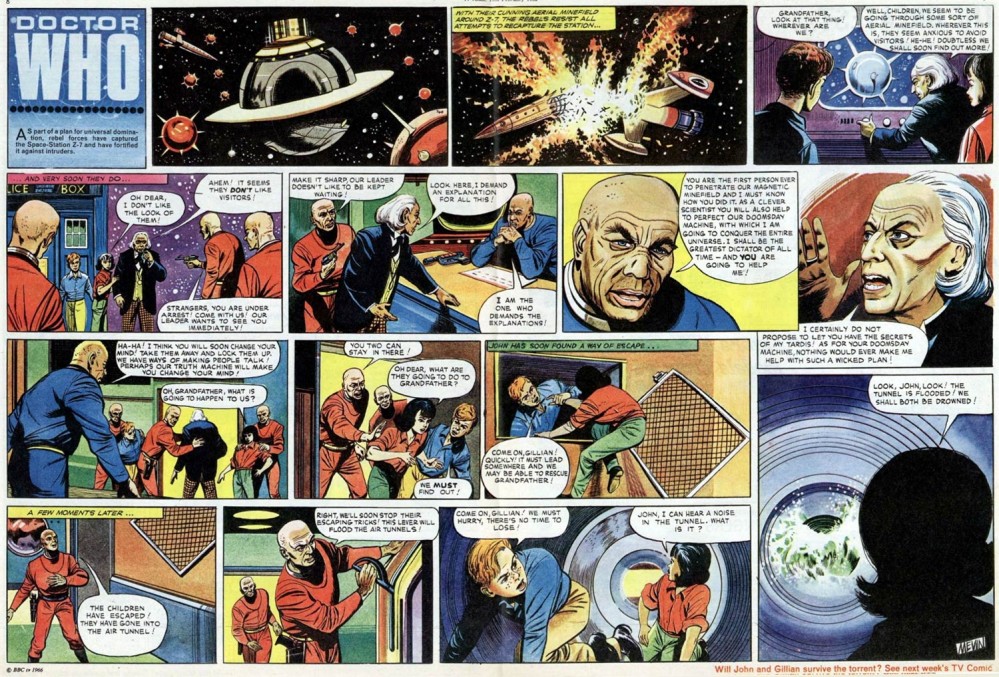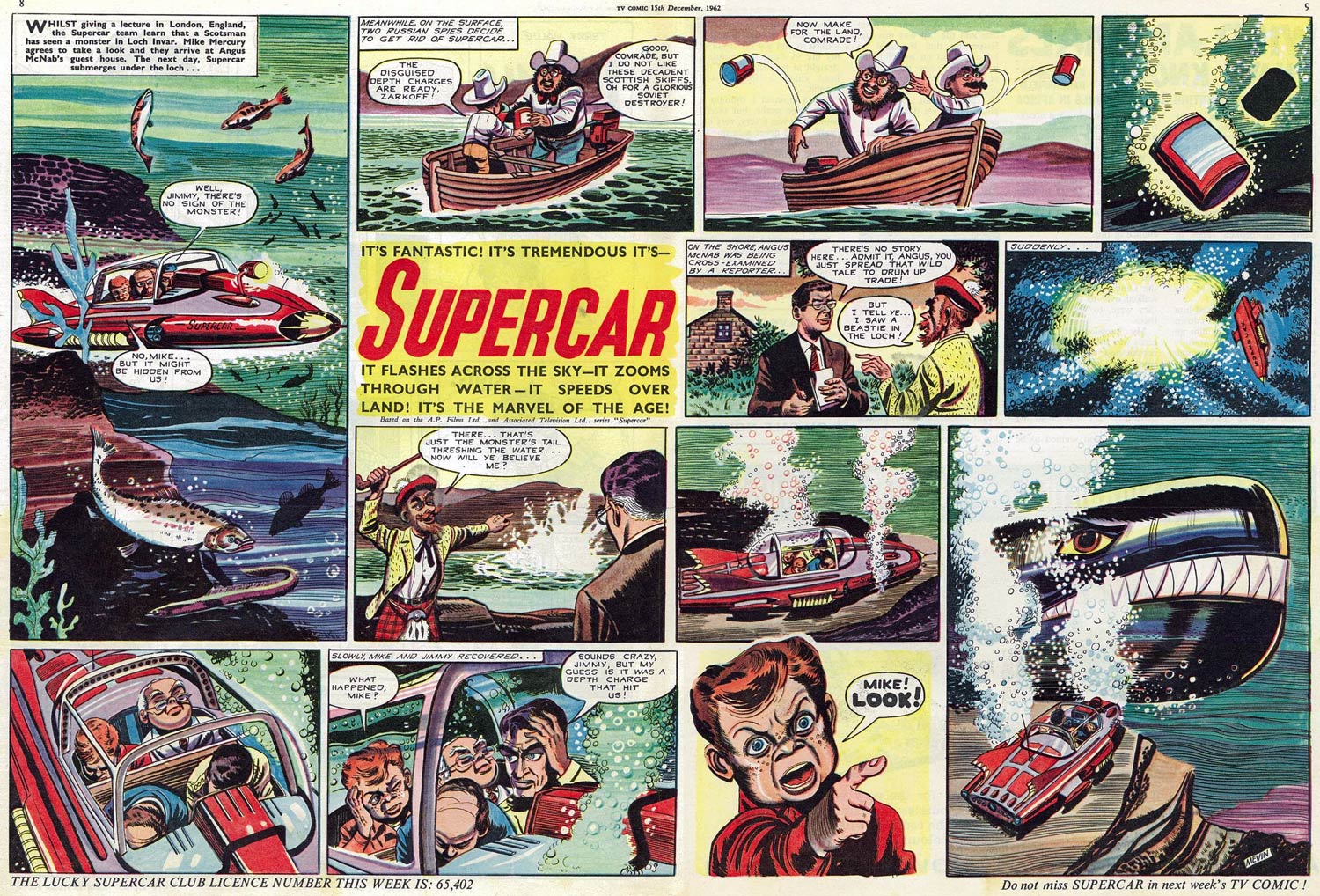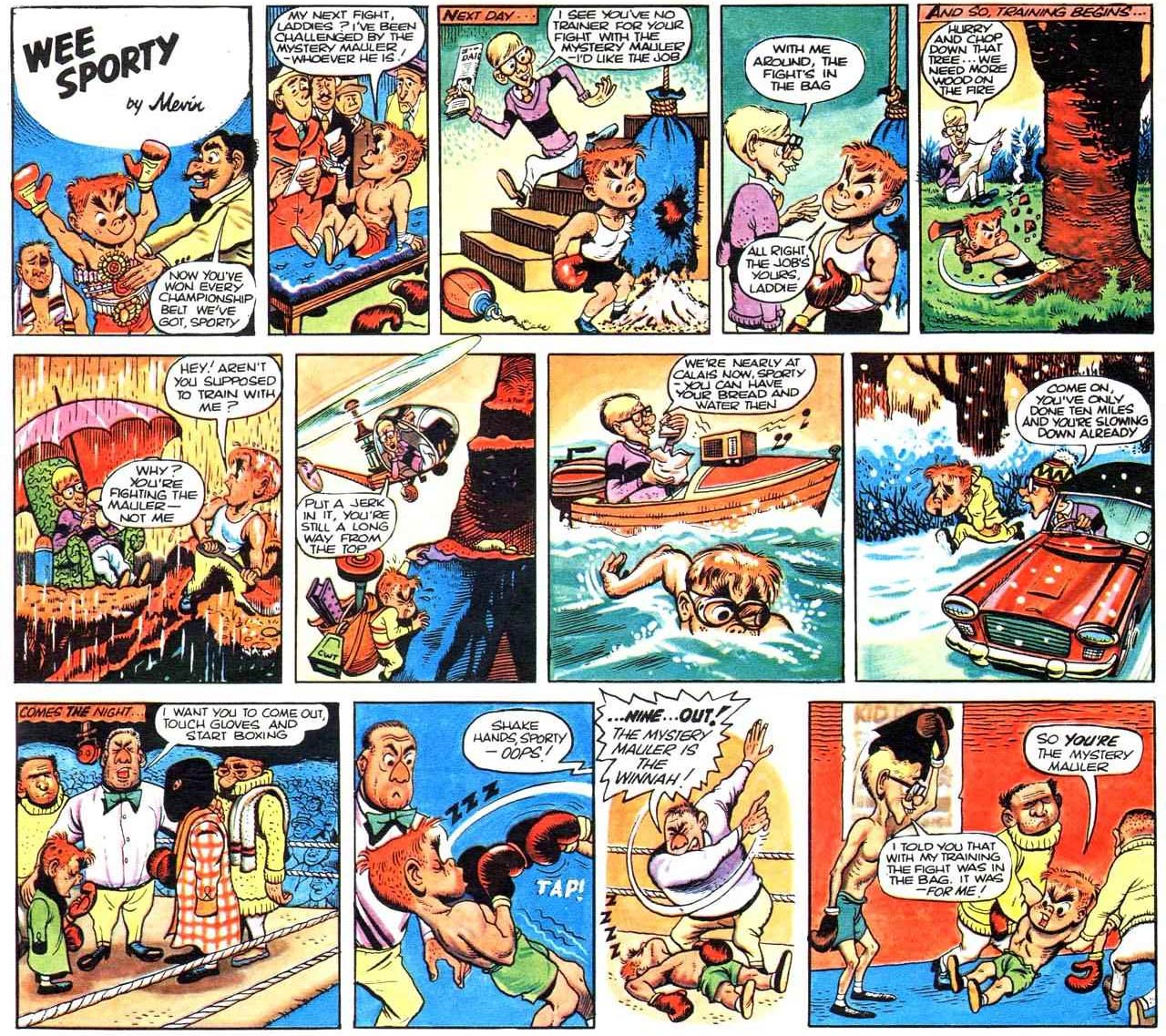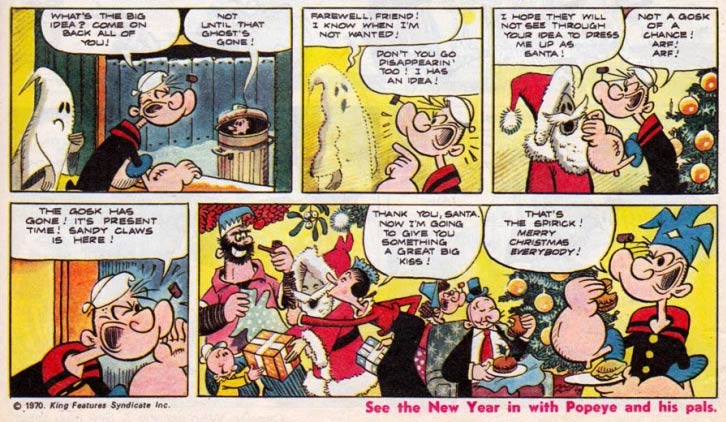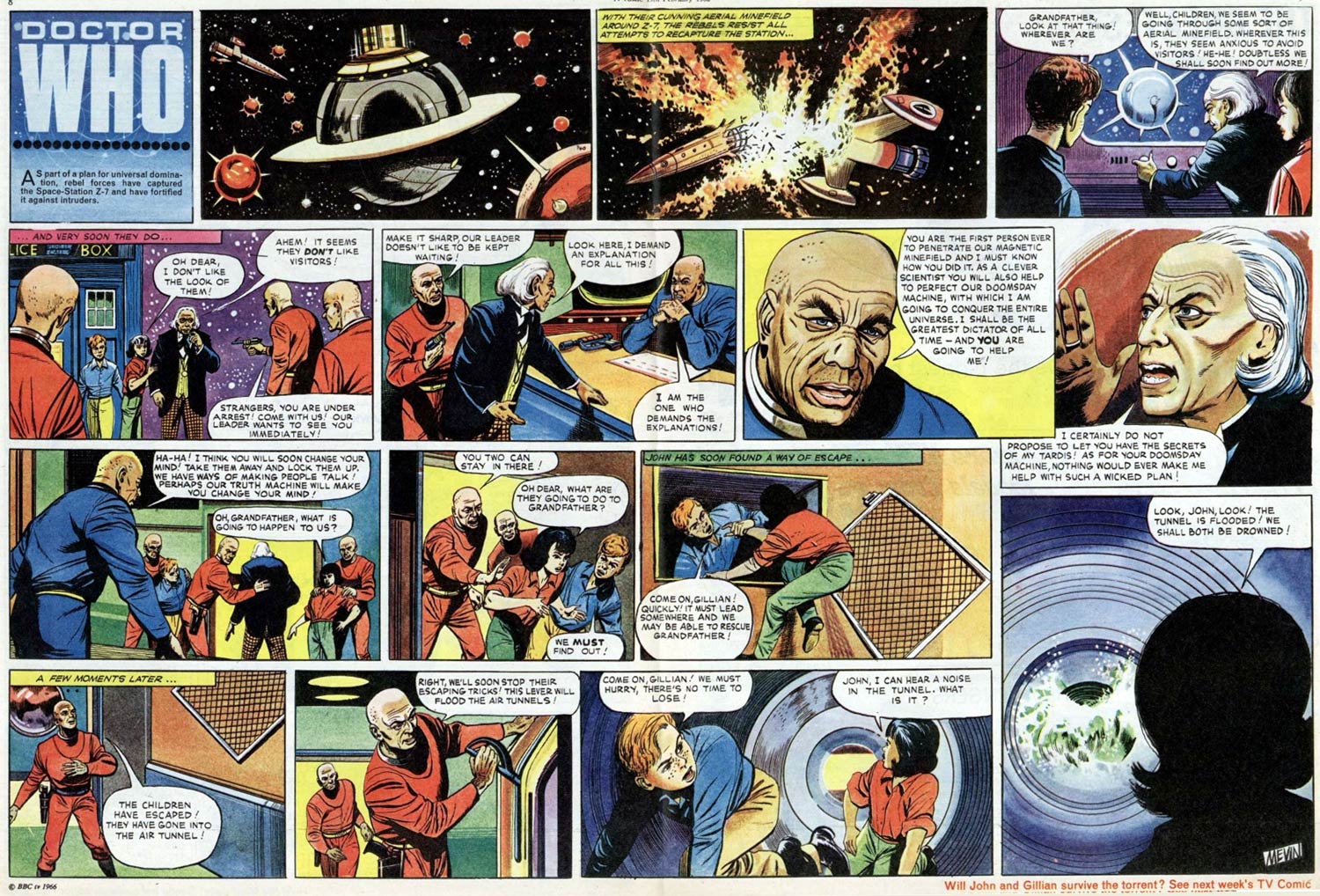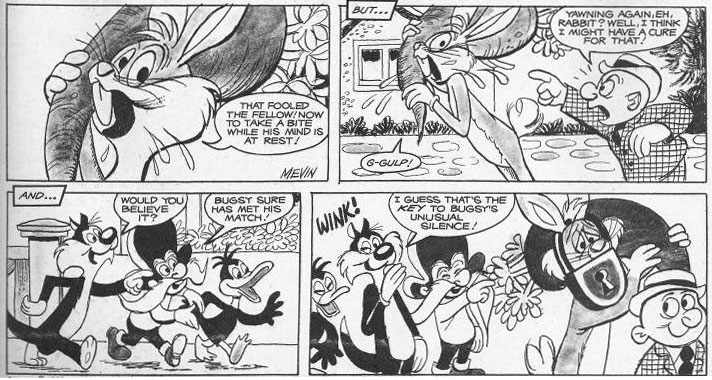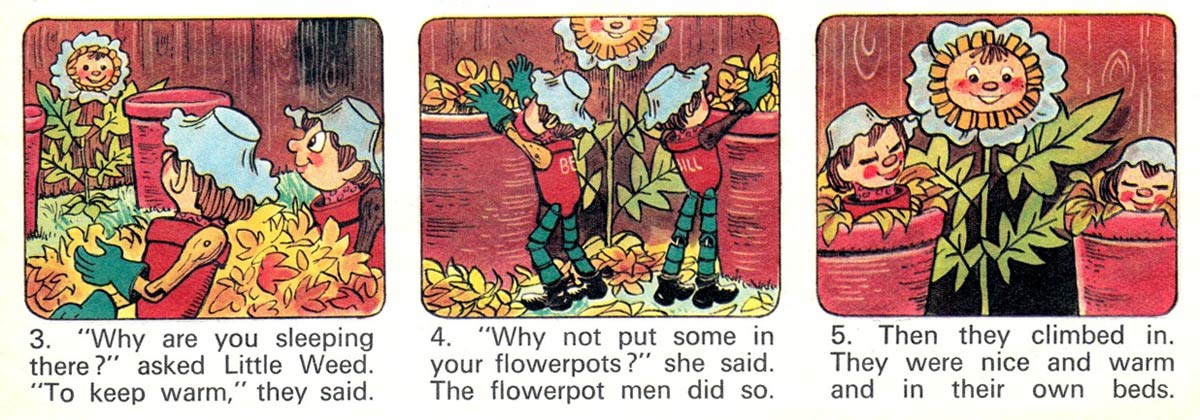'Supercar' (TV Comic, 15 December 1962).
Bill Mevin was a British comic artist and animator. From the 1950s until deep into the 2000s, he drew comics in many different styles and genres. For Express Weekly, he created the humorous sports comic 'Wee Sporty' (1956-1960). From the 1950s until the 1970s, he was most notable for creating comics based on popular TV shows, published in the children's magazines TV Comic and Pippin. Later in his career, Mevin turned to newspaper comics with 'The Soapremes' (1986-1987), a comic in The Daily Mail spoofing soap operas and TV characters. For that same paper, Mevin was also the second and final artist of the long-running newspaper comic 'The Perishers' (1992-2005).
Early life and animation career
Wilfred D. Mevin was born in 1929 in West Derby, Lancashire, and attended the Liverpool School of Art. In the late 1940s, he was a trainee animator at Gaumont British Animation, the studio set up by the American animator David Hand. When their animation department had to close down in 1949, contributed artwork to a one shilling flicker booklet about the bear 'Brumas' (1949), as part of Comic Movies Flicker Book series.
In the early 1950s, Bill Mevin joined the animation studio of Joy Batchelor and John Halas, where he, along with Brian White, Harold Whitaker and Reginald Parlett, worked on the first British animated feature film 'Animal Farm' (1954), based on George Orwell's political-satirical novel of the same name. The picture was notable for being the first feature-length animated film for the general public made on British soil. It also aimed at an adult audience, rather than children. The book revolves around a group of farm animals who revolt and establish their own society, which then turns into a dictatorship, mirroring how the ideals of the Russian Revolution resulted into Joseph Stalin's tyranny. The plot of the animated adaptation was generally faithful to the spirit of the book. Only the ending was changed to give viewers more hope that people could rise against their oppression. Unbeknownst to most of the animators, the project was financed by the C.I.A., as a propaganda vehicle against Stalinism. The British animation crew learned a lot from animation director John Reed, who had worked for Disney.
At Batchelor and Halas, Mevin also worked on 'The Power to Fly' (1954), an advertising film showing the history of aviation from Daedalus to jets, made for the Anglo-Iranian Oil Company.
Comics and cartoons
In the mid 1950s, Mevin became a topical cartoonist for the Sunday Chronicle. However, after six months, the paper merged into Empire News, and Mevin focused on drawing comics for Hulton Press. For their junior title Swift, he created the adventure serial 'Sammy and his Speed Sub' (1954-1957), and also contributed illustration work to its annuals. Mevin additionally drew comics for the Hulton Press girls' magazine Girl. From 1956 onwards, his comic gag strip 'Wee Sporty' (1956-1960) ran in Express Weekly and its successor TV Express Weekly, published by Beaverbrook. The main character is a young boy, who tries out a new sport discipline in every episode.
'Dr Who' (TV Comic, 19 February 1966).
TV Comic
Simultaneously with TV Express Weekly, Bill Mevin also appeared in Beaverbrook's TV Comic title, drawing comics based on popular cartoon characters. In the 1950s and 1960s, he drew, among others, stories starring Tex Avery's 'Bugs Bunny' and 'Droopy', MGM's 'Barney Bear' and Hanna-Barbera's 'Huckleberry Hound'. He also worked on locally produced comics based on E.C. Segar's 'Popeye', whose adventures in TV Comic had previously been drawn by Chick Henderson and Neville Main. Mevin also drew strips with ventriloquist Terry Hall's 'Lenny the Lion' character (1958-1960) and 'World Cup Willie' (1966), the mascot of the 1966 FIFA World, held in England.
'Bugs Bunny', drawn by Bill Mevin.
For TV Comic's color center-spread, Mevin drew comics built around the science fiction TV series 'Supercar' (1961-1964, succeeding H. Watts), 'Space Patrol' (1964-1965) and 'Dr. Who' (1965-1966). Mevin was a good friend of Barry Gray, who wrote music for 'Supercar', which helped the comics remain close to the show's spirit. After Neville Main, Bill Mevin was the second comic artist to bring 'Dr. Who' to life on paper. Writers involved were Roger Noel Cook and Alan Fennell. However, the comic's realistic artwork didn't quite suit him, so in 1966 Mevin was succeeded by John Canning. Decades later, Mevin created two more 'Dr. Who' comics for Doctor Who Classic Comics issue #7 (27 May 1993) and #15 (15 January 1994).
'Bill and Ben' (Pippin, 20 December 1971).
Other comic magazines
By 1960, the Beaverbrook magazines, including TV Comic, had been acquired by Polystyle Publications, and Bill Mevin also worked for other titles of this publishing group. In the 1970s and 1980s, Mevin worked for the company's children's comic magazine Pippin, which featured characters from British preschool TV shows. Mevin's worked on such features as 'The Pogles', 'Bill and Ben, the Flowerpot Men', 'The Herbs' and 'Morph'. He was additionally present in IPC/Fleetway's Whizzer & Chips with 'Happy Families', and in Whoopee with 'Dads and Lads'.
'The Soapremes'.
Newspaper comics
When the market for comic books dried out in the late 1980s, Mevin returned to newspaper comics, this time appearing in the Daily Mail. He drew the daily gag comic 'The Soapremes' (1986-1987), a parody of American soap operas like 'Dallas' and 'Dynasty'. The series was notable for featuring a lot of cameos of popular TV stars, including Joan Collins, Bill Cosby, Leonard Nimoy and Terry Wogan. In November 1992, Mevin succeeded Dennis Collins as the artist of Maurice Dodd's 'The Perishers', a strip about a gang of street kids and an Old English Sheepdog. Following Dodd's scripts, Mevin continued 'The Perishers' until the writer passed away on 31 December 2005.
Final years and death
Based in Bromley, Kent, Mevin retired in 2005, though did occasionally pick up his pencil again for special occasions, like charity auctions. In 2016, he also published a novel, 'Peggy' (Matador, 2016), about a young girl who receives a flying pony from the Greek god Zeus. In late 2019, Bill Mevin was hospitalized, and died some weeks later, at age 97.


